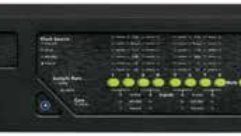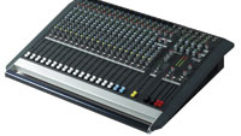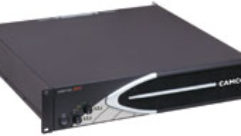
Technology Showcase: Digital Equalizers
Apr 1, 2004 12:00 PM,
By John McJunkin
Gold Line EQ2 display
Equalization is eminently important to the systems integrator for a number of purposes. Chief among these is to tune the P.A. for the venue and to control feedback in stage-monitoring systems. Over the years, analog equalizers have become much more sophisticated, and the level of quality has risen over time, as well. Digital equalizers are not new, but they are only now becoming a mainstay device for most systems integrators. I’m taking a look at digital EQs exclusively, and because I have limited space with which to work, I have chosen to restrict this showcase to products that provide digital equalization for a minimum of two channels as their primary function. I chose not to include crossovers, because that would require a magazine that weighs more than a subwoofer! Some of the products included also provide dynamics processing, among other things, but are primarily intended to be thought of as equalizers. By no means do I profess that the selection of products here is comprehensive, but I have included most of the popular brands and models available.
I decided to categorize these products by the following criteria: pure ⅓-octave graphic equalizers, parametric equalizers, as well as digital signal-processing (DSP) units that provide more than just EQ. I’ll first examine the straight-up ⅓-octave graphic units.
PLAIN VANILLA EQUALIZERS
The Alesis DEQ230D features digital I/O.

The first unit is the Alesis DEQ230. An alternate version, the DEQ230D, offers digital I/O and MIDI control. Otherwise both units are the same, featuring 12 dB of boost or cut on each of 30 bands ranging from 25 Hz to 20 kHz, with 13-segment LED displays for each of the 60 bands (30 left, 30 right). A two-digit LED display depicts program numbers. Converter resolution is 24-bit/48 kHz sampling rate, and internal processing is accomplished with 28-bit resolution. The DEQ230 has balanced ¼-inch inputs and outputs (switchable between +4 and -10 levels), and the DEQ230D has S/PDIF coaxial inputs and outputs. Both units ship with 30 presets and have 30 memory locations for user programs. Left and right channels can be linked on both, not to mention that the EQ can be bypassed. A locking feature prohibits unauthorized changes to equalization, which is particularly nice in a DJ-booth setting where dozens of guest DJs can stream through the venue each week. Alesis also has the DEQ224, which is a 24-band version (25 Hz to 19 kHz) of the DEQ230. Aside from the elimination of six bands, it’s pretty much identical to the 230. Final among Alesis’s offerings is the DEQ830, which is, for all practical intents and purposes, an 8-channel version of the DEQ230. There are some notable distinctions. Analog I/O consists of eight ¼-inch balanced inputs and outputs (which can be switched between +4 and -10 levels), and the digital I/O is handled completely by ADAT Lightpipe. Each of the eight discrete channels has a ten-segment LED meter, and a three-digit LED display shows which of the 50 presets or 100 user programs is in effect.
Strictly speaking, Phonic’s I-7600 Supra Curve is a bit more than just a ⅓-octave stereo EQ. It also features a 29-band real-time analyzer, a useful tool for systems integrators. However, because EQs and RTAs go together like hand and glove, I’ll address this product in this section. Conversion is 24-bit resolution, and internal number crunching happens at 32-bit resolution. Twelve decibels of boost or cut are available on each band, and left and right channels can be linked. The unit also features a lowpass and a highpass filter, as well. The RTA display has six refresh rates available, along with six distinct level ranges. The unit’s built-in pink-noise generator is another nice addition.
Yamaha’s YDG2030 offers ⅓-octave graphic EQ, as well as notch, highpass, and lowpass filters. As many as 714 ms of delay is also available, which is nice because it saves you money on a standalone delay if you’re using this EQ on a delay tower or another distributed system. There are two ⅓-octave modes. In one, 6 dB of boost or cut is allowed, and in the other, 12 dB of boost or cut can be achieved. “Sweeping” to wring out monitors is a nice feature of this unit. Four notches and a single highpass and lowpass filter are available on each of the two channels. The notch filters are truly parametric, with adjustable Q. Even though parametric filters are available, the primary function of this unit is as a ⅓-octave graphic EQ.
PARAMETRIC EQS
There are only two purely parametric digital EQs to discuss, the first of which is the Gold Line EQ2. This is a unit that is intended for use with a Windows-based computer as its front end. Based on the Motorola 56002 DSP, it sports ten bands of parametric filters, highpass, lowpass, and shelving filters, and two discrete delay lines on each of its two channels. Boost can be up to 12 dB, cut can reduce by up to 20 dB, and converter resolution is 20-bit. Balanced XLR connections are available, as are unbalanced, gold-plated RCA connections. Delay can be as much as 170.66 ms, adjustable in increments of 20.8 µs (equivalent distance of ⅓-inch.) The highpass and lowpass filters have both 6 and 12 dB/octave slopes available. If you have a Windows machine available, this is a powerful equalizer.

The other parametric unit is the XTA DP202. It features balanced I/O, and AES/EBU digital I/O is an option. Optical I/O is a special-order option, as well. Eight fully parametric EQs are available for each of two channels, yielding boost of up to 15 dB or cut of 30 dB, in 0.1 dB increments. Q can range from 0.4 to 128. High- and low-shelving filters with ±15 dB of adjustment in 0.1 dB increments are also available. Highpass and lowpass filters are offered with Bessel or Butterworth response at 12 or 24 dB/octave or Linkwitz-Riley response at 24 dB octave slope. The unit also gives you delay of up to 682 ms and a limiter per channel, as well. It sports an LCD and MIDI I/O for connection to a computer.
MULTIPURPOSE DSP BOXES
Equalization is not the only signal processing that digital circuits can yield. Dynamics processing, delays, and other even more esoteric things can be accomplished with DSP. For all intents and purposes, it makes a lot more sense to use the horsepower of the DSP chip to accomplish other important processing in addition to EQ. That is clearly the direction most manufacturers are headed these days. The notable absence in this selection of products is crossovers. Frankly, there are so many that I simply don’t have the space, and it’s a topic best saved for another day. What I will cover is any box whose primary function is equalization but also has a rich feature set of other DSP. I’ll also examine some products that exist in master/slave configurations.
First in line is the Ashly Protea Series 4.24G. This is a 24-bit/100 kHz sampling rate 28-band graphic EQ with 24 dB/octave highpass and lowpass filters. Up to 1.364 seconds of delay is available, as well, and as many as 16 channels of audio can be controlled through the aforementioned master/slave-style expansion. One truly excellent option with the 4.24G is the 4.24RD remote control, which lets you literally dial up EQ as you walk anywhere in the venue — very nice! Up to 15 dB of boost or cut is available on any of the 28 bands, in 0.5 dB increments. Also, this is a 4-channel unit, making it useful for stage-monitor systems or multichannel front of house. Copious computer interfacing (including MIDI and RS-232) is featured, as are both XLR and ¼-inch balanced audio inputs and outputs.
Behringer’s DEQ1024 is a ⅓-octave EQ/RTA/feedback destroyer with a noise gate, a peak limiter, and a spatial enhancer. Sweepable high- and low-cut filters are also featured, along with a pink-noise generator. AES/EBU and S/PDIF interfaces are included, with 24-bit amplitude resolution and sampling rates of 44.1, 48, and 96 kHz. The unit can be hard-bypassed and is automatically bypassed in the case of power failure. Balanced XLR and ¼-inch inputs and outputs are featured, as well. The feedback destroyer can insert as many as ten notch filters per channel, each with a
1
/
10
-octave bandwidth and a depth of up to 48 dB.
Behringer also offers the DEQ2496, which yields versatile DSP for P.A. purposes and “audiophile mastering,” as per the manufacturer’s specification. Four concurrently selectable EQ modules are available: a ⅓-octave graphic EQ, a 10-band parametric EQ, a feedback destroyer, and three frequency-dependent EQs. A dynamics section yields compression, expansion, as well as a separate peak limiter. As with the DEQ1024, a spatial enhancer is included, and the DEQ2496 also features a stereo delay. A 61-band real-time fast Fourier transform helps in the tuning of the P.A. for the venue. Converter resolution is 24-bit/96 kHz sampling rate, as the name implies, and internal DSP is accomplished at 32-bit resolution.
Behringer’s final entry into the list is the DSP8024. Once again the primary function is a ⅓-octave graphic EQ, but the unit also enables further contouring with a low/high/bell shelving tool and six bands of fully parametric filtering with bandwidth selectable down to a narrow
1
/
60
-octave. The DSP8024 also features its own pink-noise generator, a mic input, and an algorithm to easily tune a P.A. for the venue. A brickwall limiter and noise gate are also present. Through software and a MIDI interface, the unit is controllable by a Windows computer. There are 100 user memories available, and password-controlled security helps protect them. Curves can be copied, compared, or added and subtracted, which is a truly powerful feature. Converter and internal resolution is 24-bit/96 kHz sampling rate.
Inter-M brings the GEQ-1231D and the GEQ-2231D, which are similar units. The distinction is that the 1231 controls two channels with a single set of ganged controls (in a permanently stereo-linked fashion), whereas the 2231 actually features separate vertical sliders for the distinct bands of each channel. Otherwise the two are identical. These are ⅓-octave EQs with constant-Q, boost ranges of either 6 db or 12 dB and cut of 24 dB. High-cut and low-cut filters are included for rumble and hiss suppression, respectively. In addition, peak limiting is featured, and the entire unit can be hard-bypassed. Converter resolution is 24-bit/64 kHz sampling rate, and internal math is done at 40-bit resolution.
Inter-M MEQ-2000

Inter-M also offers the MEQ-2000, which is more of a multipurpose DSP than either of the other two offerings. This box is first and foremost a ⅓-octave graphic EQ but also features an 8-band parametric EQ, 6-band notch/low-cut/high-cut filters, dynamics processing, and delay. Conversion resolution is 24-bit/96 kHz sampling rate, and a sophisticated sampling-rate converter enables the unit to accept (and output) sample frequencies from 20 to 100 kHz. The internal signal-path amplitude resolution is 40-bit, and math is done at up to 80-bit accuracy. Dithering is available at 16, 20, or 24 bits, and MIDI and RS-232 interfacing are featured, enabling remote control of the unit through proprietary software. The “mastering” limiter/compressor is capable of adaptive-knee and autorelease, yielding sonically pleasing results.
Klark Teknik DN9340

The Klark Teknik DN9340 is a stereo unit that features an impressive array of filtering and EQ, not to mention delay and frequency-dependent dynamics. The ⅓-octave graphic boosts or cuts up to 12 dB in 0.1 dB increments with five distinct Q response curves. As many as four filters are concurrently available, including notch, lowpass, highpass, high shelf, and low shelf. The Q of the notch can range from 1.0 to 150 in steps of 1.0. A multitude of slopes are available, ranging from 6 dB/octave to a supersteep 48 dB/octave. Two bands of mastering-style frequency-dependent compression are also available for a nice final polish. As much as one second of delay is available in ⅓-inch steps.
LA Audio DPF3103

The LA Audio DPF3103 is another of the master/slave-type processors that can add channels on a modular basis. Essentially, it is a 24-bit, 31-band ⅓-octave graphic EQ, with parametric and shelving EQs and highpass and lowpass filters. A compressor/limiter and noise gate are also included. Optional processing includes delay and RTA. Analog and digital I/O options are both available. Internally, this unit can store as many as 98 programs. Instantaneous live toggling between presets is allowed for A/B comparison, with no interruption of the signal. In addition to the master/slave arrangement, computer control of the unit is also available, with as many as 32 channels of audio under control from a single front end.Sabine offers the Graphi-Q (GRQ3100 Series) EQ, which comes in single- and dual-channel configurations, with slave versions available to add channels on a modular basis. Fundamentally, the unit is a ⅓-octave graphic EQ with both ±6 or 12 dB boost or cut. Sabine’s patented (and celebrated) FBX Feedback Exterminator is also included, which features 12 filters under digital control to eliminate feedback. A limiter is available, distinct of an available compressor. Twelve parametric filters are featured, as well, along with a digital delay of as long as one second. Graphi-Q remote-control software for Windows yields control over all the major functions of the unit from a computer, including high-resolution graphical representations of equalization curves and compressor/limiter input versus output displays. Low- and high-cut filters are also available.Sabine’s other multi-DSP offering is the Power-Q (ADF-4000 Series). This unit is similar to the GRQ3100 but sports a few added features. The main function is a ⅓-octave graphic EQ, of course, but 12 bands of parametric EQ as well as highpass and lowpass filters are also added. Like Klark Teknik’s EQ, the filter Q is adjustable in graphic EQ section of this unit. As many as 12 bands of Sabine’s FBX feedback destruction are available. This unit adds an RTA, complete with a reference mic input. In the same fashion as Behringer’s DSP8024 unit, the Power-Q does automatic room tuning. Another slick feature is Environmental Artifact Removal, which analyzes, isolates, and ignores constant ambient room noise (like air-conditioning rumble) so that the low end is not eliminated, for instance. A compressor/limiter is featured, along with a noise gate/expander. As expected, delay is also available, and of course, computer control is also featured.Shure’s DFR11EQ is another all-in-one solution for equalization, dynamics, and time alignment, among other things. Basically, it’s a ⅓-octave graphic EQ yielding 6 or 12 dB of boost or cut, with ten 1/10-octave adaptive notch filters under digital control to eliminate feedback. There are also ten bands of fully parametric EQ, yielding 6 dB of boost or up to 18 dB of cut. Slope ranges from 6 to 24 dB/octave. As much as 1.3 seconds of delay is available, in addition to a limiter. One particularly nice feature of this product is that it fits in a half rackspace. If you need multiple channels, you fill up your rack only half as quickly. Conversion resolution is 20-bit/48 kHz sampling rate, and the EQs can be stored and made tamperproof, as well. An RS-232 interface allows computer control and future firmware updates.MANY CHOICESAs you can see, there are numerous choices available for the integrator who wants digital equalization, ranging from very fundamental to tremendously sophisticated. My advice? Shop carefully and put a lot of thought and analysis into what your needs are. You may, for instance, reach the conclusion that the high-end, all-in-one boxes are more than you need. In fact, however, you may be able to reduce the bulk (and weight!) of your racks by having one 2U box that accomplishes what five separate units used to do. Above all else, I proffer the universal and timeless advice to listen. All the specs and numbers in the world mean nothing until you prove to yourself that your ears are actually happy with the results.John McJunkinis the principal of Avalon Audio Services in Phoenix and engages in consulting for both studios and live sound applications.For More InformationAlesis
www.alesis.comAshly Audio
www.ashly.comBehringer
www.behringer.comGold Line
www.gold-line.comInter-M Americas
www.inter-m.netKlark Teknik
www.telex.comLA Audio
www.laaudio.co.ukPhonic America Corp.
www.phonic.comSabine
www.sabine.comShure
www.shure.comYamaha
www.yamaha.comXTA
www.xta.co.uk









